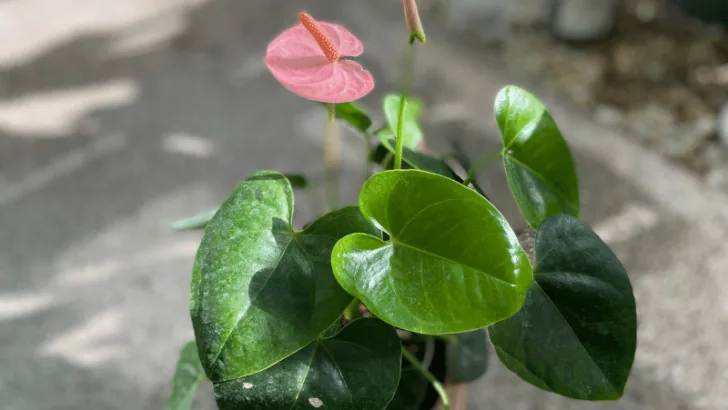You are here to learn about the Anthurium Flower and Anthurium plant care.
The Anthurium is a flowering plant also known as the Flamingo flower. There are more than 1000 different species in the Anthurium genus. This genus belongs to the Araceae or Aroid family.
The botanical name for the Painters palette plant is Anthurium andraeanum, according to NC State University.
Initially found in the rainforests of South America, namely Columbia, and Ecuador, these plants are happily grown indoors and outdoors in USDA hardiness zone 10 to 12, according to Missouri Botanical Gardens.
Read on to discover how I keep my Flamingo Flower happy.
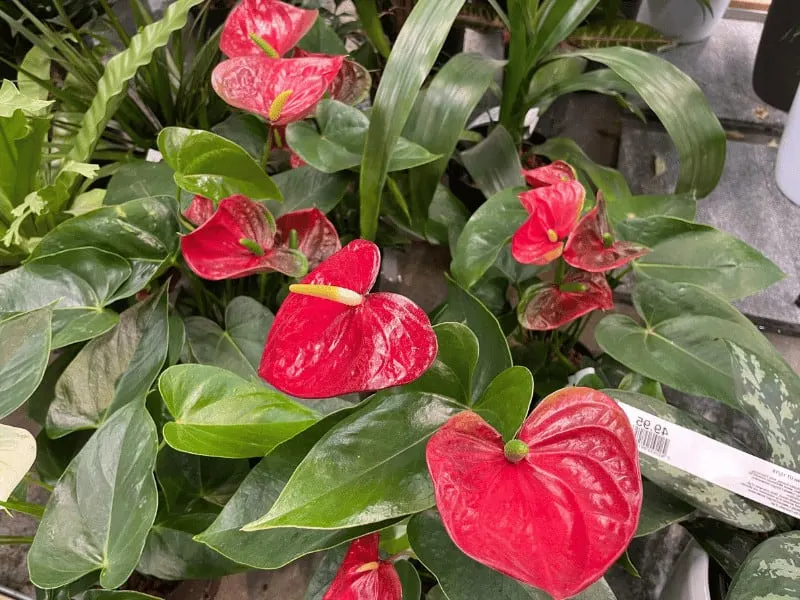
Table of Contents
Anthurium andreanum
| Species | Anthurium andreanum |
| Synonyms | Tailflower, Flamingo flower, Laceleaf, Painter’s palette, Flamingo Lily |
| Family | Araceae |
| Genus | Anthurium |
| Propogation | Division, seed germination, or cuttings |
| Growth | Herbaceous clump-forming evergreen |
| Height | 1.5 feet |
| Soil | Airy, well-draining soil consisting of orchid bark, perlite, coco coir or peat moss, and charcoal |
| Watering | Water every 5 to 7 days |
| Light | Bright indirect |
| Temperature | 77 to 92°F |
| Humidity | 70-80% |
| Fertilizer | Fertilize 2 times per month |
| Propagation | Division, seed germination, or cuttings |
| Toxicity | Toxic to animals such as cats and dogs as well as humans. Contains calcium oxalate crystals |
Anthurium Plant
Anthuriums are perennial herbaceous plants that produce a spathe and spadix. The spathe is a modified leaf. The spadix is upright and contains tiny flowers. These are the blooms and not the spathe and spadix itself.
The blooms emerge from the axillary bud or lateral buds. These buds have the potential to grow new stems and branches or flowers.
When the inflorescence is pollinated, it will produce berries that contain seeds.
Anthuriums grow in humid forests.
Anthurium Care Indoors
- Soil: Choose airy, well-draining soil with orchid bark, perlite, coco coir, peat moss, and charcoal.
- Light: Provide bright indirect light; avoid direct sunlight to prevent leaf burn.
- Watering: Water once weekly, keeping the soil slightly moist, but avoid overwatering to prevent root rot.
- Temperature: Maintain temperatures between 77-92°F (25-32°C) for optimal growth.
- Humidity: Aim for 70-80% humidity, especially in a tropical setting.
- Fertilizing: Use a balanced fertilizer (NPK 10-10-10 or 14-14-14) every two weeks during spring and summer and monthly in autumn and winter.
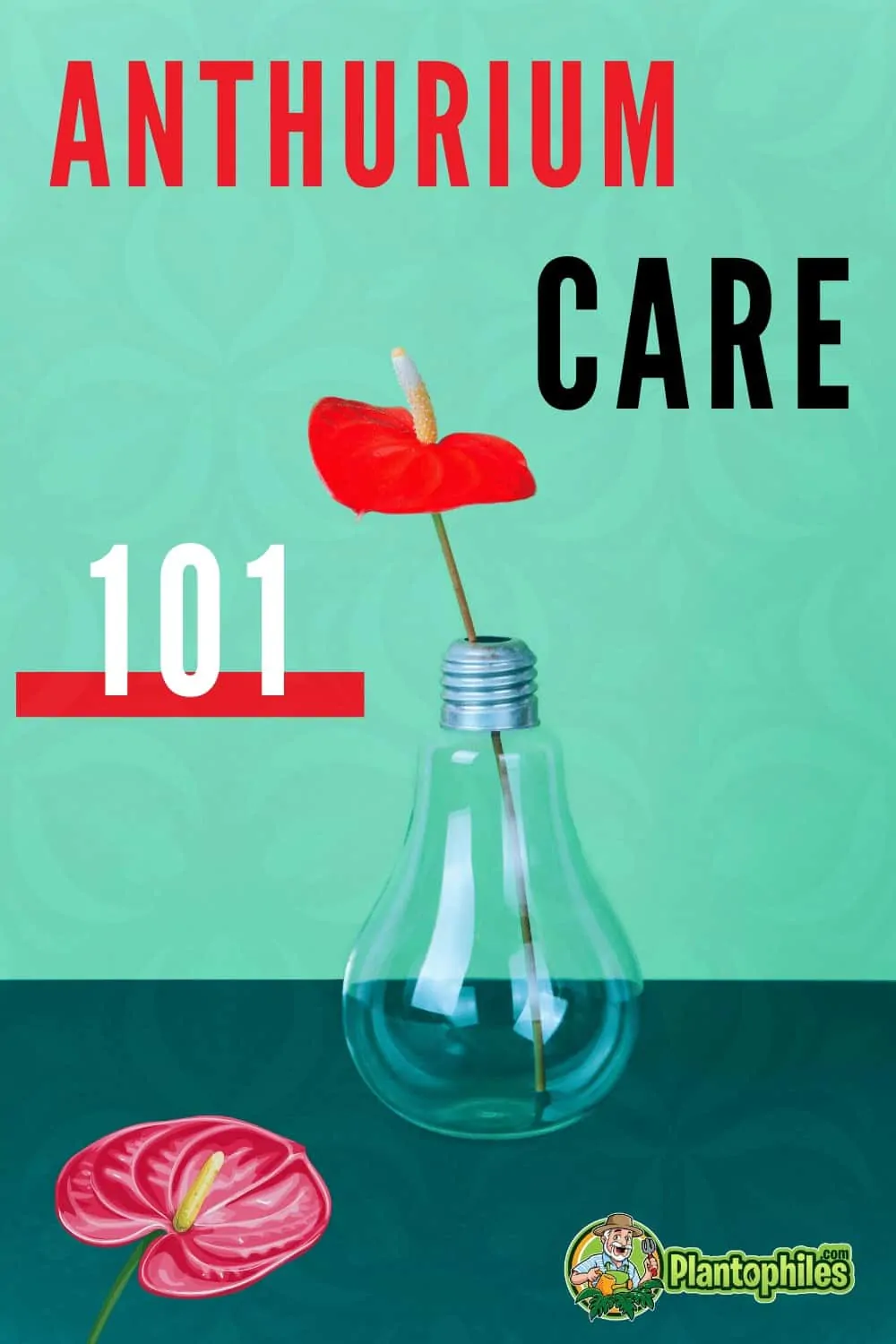
How to grow Anthurium andraeanum Video YouTube
Anthurium Care Outdoors
According to the University of Florida, Anthuriums grow best in low-light conditions outdoors. But low light outdoors is not the same as indoors. The sunlight is very strong, even in the shade.
You can grow this tropical plant ins USDA hardiness zones 10 and above.
Anthurium plants are easy to grow. Below is all you need to know about how to care for this houseplant.
What Soil is best for an Anthurium
The best soil for Anthurium plants is well-draining and consists of orchid bark, perlite, coco coir or peat moss, and charcoal.
These indoor plants can survive on a wide range of soil types as long as they are airy and high in organic matter. The soil provided should also have adequate drainage to prevent the potential of root rot.
The Anthurium plants are epiphytes. Epiphytes are growing on other objects and plants.
Ephyphite mixes are available in the form of aroid mixes or orchid mixes. They are well-draining and airy.
Read about the ideal soil for Anthurium.

What is the best light for an Anthurium plant?
Bright, indirect sunlight is best. The ideal placement is an east-facing or west-facing window.
Placing these individuals in a room with plenty of light is important. Low light will slow growth, prevent blooming, and cause a dull-looking plant.
Avoid direct sunlight for more than 4 hours. Direct sunlight can burn the leaves.
In winter, I use as grow light to ensure my plants get sufficient light.
Read about how much light Anthurium needs.
How to Water the Painter’s Palette Plant?
Water Anthurium plants once a week when the soil is dry.
Keep the soil of these plants slightly moist but never soggy.
Adhere to a regular watering schedule.
These houseplants require low to moderate amounts of water.
Depending on how warm their environment is, you may need to add water every seven days.
Providing ample drainage holes on the bottom of your pot or container prevents root rot.
Read more about watering Anthurium.
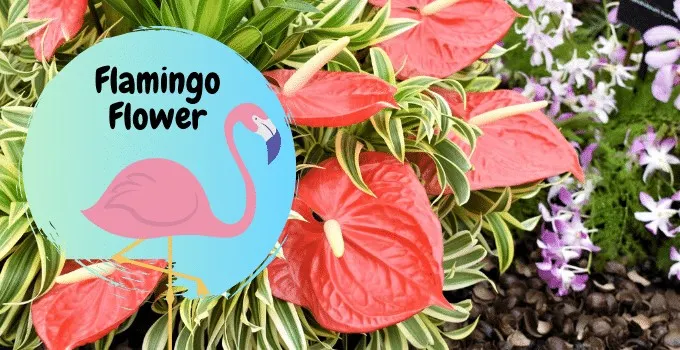
What is the ideal Temperature for an Anthurium?
The temperature for Anthurium plants during the daytime should be between 77-92°F (25-32°C), while the evening temperatures can be around 70-75°F (21-24°C).
Being a tropical plant, it prefers higher average temperatures.
Anything lower than 39 degrees Fahrenheit (4 degrees Celsius) can result in poor growth and damage to the leaves.
How much Humidity does the Anthurium andraeanum need?
The ideal humidity is 70 to 80%.
These tropical plants prefer high humidity. Anthuriums indoors need more water compared to growing them outdoors.
A humidifier can help improve air humidity. Place your plant in the bathroom or close to the kitchen sink, and putting plants together helps increase the humidity as well. Misting is not recommended as it does not increase air humidity and might lead to leaf rot.
You can use a pebble tray underneath the pot to fill it with water. This increases humidity. Just ensure to refill it regularly.
Read more in the Anthurium humidity guide.
How often should I fertilize an Anthurium?
Use a fertilizer with an NPK of 10-10-10 or 14-14-14 every two weeks in spring and summer, depending on the light intensity and the species of Anthurium, according to the University of Florida.
Reduce fertilization to once a month in autumn and winter. Your plants grow slower and hibernate.
Anthurium plants grow best using a well-balanced fertilizer. Read more in my detailed guide about Fertilizer for Anthurium.
Do not overfertilize as this can burn the roots.
Flamingo Flower Growth
Flowering Anthuriums generally grow to a height of 1.5 feet (45 cm) and 1 foot in width (30 cm). The flowers themselves tend to last several weeks. The Flamingo flower can grow up to 4″ a year (10cm).
Cut Anthurium flowers can last up to 6-10 weeks. They make excellent cut flowers for vases.
The Flamingo flower leaves and blooms are glossy. The flowers have a waxy texture. The leaves are heart-shaped.
New growth emerges as small leaves or flowers. They increase in size over time. So the final size of a leaf or bloom can only be judged after several weeks.
If your Anthurium is not flowering, read my extensive guide on common issues here.
Potting And Repotting
Repot every 2-3 years. It takes years for them to become root-bound. Repotting this plant is important to avoid stunted growth. This should be done carefully. The flowers are quite fragile.
When potting, use a pot with drainage holes. Excess water needs to drain immediately. I had good experiences with clay pots for my Anthuriums. They soak up any excess water. You must ensure you water regularly so your plants do not dry out.
Read more about repotting Anthurium plants.
Anthurium Flowering
Flamingo flowers have a spathe and spadix called a flower or inflorescence. The spadix is the tail inside of the flower. Anthuirums produce heart-shaped bracts, and slender clusters of flowers characterize these plants.
The colored spathe is a bract. A bract is a modified leaf. The bract is waxy and is colored red, pink, yellow, rose, or white. Most people think it is a flower, but it is not.
These plants bloom throughout the year. The larger and more mature they get, the more flower spikes they carry.
The flower stems are upright. The blooms are usually red. But there are different cultivars with green, pink, white, and creme flowers available most people say the flower is the spathe. The flower is lacquered and shiny.
The flowers last up to 6 weeks. Once they are over, they become brown, wilt, and die.
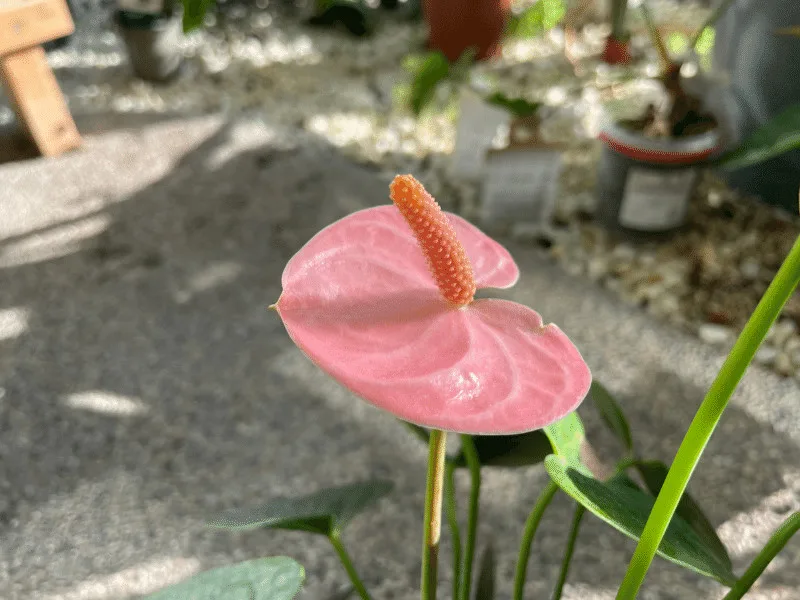
How to Propagate Anthuriums
Propagating Anthuriums is done through division, seed germination, or stem cuttings.
All of these methods are fairly easy, even for a beginner. Many plant enthusiasts enjoy creating Anthurium hybrids.
Below is a detailed step-by-step guide on how to make a beautiful clone out of your Anthurium specimen.
Propagation Through Stem Cuttings
- Choose a healthy parent plant you want to duplicate and locate a stem at least six inches long with two or more leaves attached.
- Make a clean incision with pruning shears and put the new cutting into a small pot. Be sure to check the underside for ample drainage holes.
- Double-check that the cutting is placed into the soil directly. This should be about two or three inches deep, with the leaves on top of the soil.
- Fully saturate the soil with water and add moisture every other day so the top layer does not dry out. The trick of the trade is that these plants need a lot of moisture to grow.
- Once the new individual has been placed in a spot with high humidity and indirect sunlight, wait for the roots to develop.
- Expect to see roots take form anywhere from four to six weeks. You can slow your watering routine and treat it like an adult Anthurium.
Propagation Through Division
- Pick out the Anthurium you want to copy, preferably one with “leggy” or congested roots.
- Remove the individual from the pot so it is exposed and can be divided as cleanly as possible.
- Using a sharp knife, separate the clumps of roots, so you have two sections. You may have excess soil, but you can eliminate this by carefully shaking the dirt free from the roots.
- Take each clump and put them into respective pots with fresh soil.
- Thoroughly water the two pots so that the soil can be fully saturated.
- Move the plants to an area with partial sunlight, and keep them evenly watered over.
Read more about the Anthurium division process as well as Anthurium propagation.
Anthurium Pruning Steps
Anthurium scherzerianum needs pruning to stay healthy. It is a slow-growing plant but thrives from multiple growth points. Trim them every three to five months. Taking away too much of the foliage will stunt future growth.
Pruning Steps:
- The best time to prune this Araceae is directly after it has finished blooming.
- Start from the top and work your way down
- Carefully remove any dead or yellowing leaves
- Cut off blossoms that aren’t blooming anymore
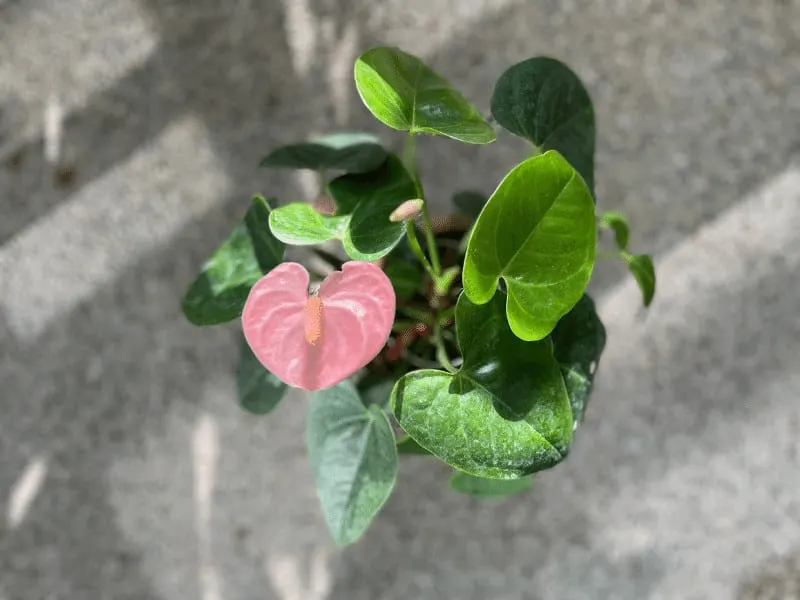
Anthurium are some of the longest-lasting flowers. Read about tips to increase Anthurium vase life.
Anthurium Pests
Common pests on an Anthurium are mealybugs, scales, fruit flies, thrips, spider mites, whiteflies, and fungus gnats. Anthuriums are not very prone to diseases in general.
Regularly check your plant’s leaves, stems, flowers, and the potting soil. Look out for crawling bugs. Pests can be tiny.
To get rid of pest infestations, the best remedies I have found to work are horticultural soap, neem oil, rubbing alcohol, beneficial nematodes, and a systemic insecticide.
I spray all my plants every two weeks using a spraying bottle, some drops of dishwater soap, and rubbing alcohol diluted in water.
This dissolves some bad bugs directly when they come in contact. In addition, it prevents plant pests from chewing on the leaves and stems.
Most plant pests are sap-sucking insects. They deprive your Anthurium of necessary nutrients. Discolored leaves and dying plants are the result.
I use beneficial nematodes when pests like mealybugs and thrips settle on my plants. These are good bugs that you can use against bad bugs.
You need the right bug to prey on specific bad bugs. For example, for my thrips infestation, I used Amblyseius cucumeris.
If everything fails, my last resort is systemic insecticides. I use these sparingly as it has the potential to harm the environment.
Are Anthuriums Toxic?
Anthurium plants are toxic to cats, dogs, and humans as they contain insoluble calcium oxalates. The sap can lead to skin irritation and eye irritation in humans and animals, according to ASCPA.
My Anthurium Leaves are Curling – Why?
Cause: Those who notice that their Anthurium’s leaves start to curl under can expect that it is related to a lack of water.
Remedy: Change your watering schedule to solve this issue and avoid any long-term damage. Start by thoroughly saturating the plant and then work your way to find the right balance.
Read more about curling leaves on Anthurium.
The Leaves of my Anthurium have Brown Spots
Cause: Brown spots on the leaves can mean one of two problems. Either the plant is not getting the necessary nutrients, or there is too much direct sunlight.
Remedy: Move the plant to a room with less light. If that doesn’t work, add a diluted fertilizer at one-third of the usual strength once a month in spring and summer, the main growing season.
Read more about why leaves are turning brown.
The Anthurium Flowers are Turning Brown – What is wrong?
Cause: The cause can be natural. But other causes are overwatering, underwatering, cold shock, and repotting. Brown flowers indicate that your plant care is not on point.
Remedy: Adjust your watering or fertilization schedule. Ensure that you meet the plant care requirements and look at the most common reasons why Anthurium flowers turn brown.
Read about common Anthurium problems.
My Anthurium has Brown Leaves
Cause: If your Anthurium flower develops brown leaves, the most common reason is underwatering. Other reasons are a natural cause, overwatering, too much sunlight, and pests.
Remedy: Water your Tailflower every 5-7 days and keep the soil slightly wet. Check the soil humidity by sticking your finger 1-2 inches into the dirt (2.5-5cm).
Why does my Anthurium have Yellow Leaves?
Cause: The common cause for yellow leaves on Flamingo Flowers is overwatering. Other reasons can be pest infestations and underwatering.
Remedy: Reduce watering. If the soil stays soggy and wet for several days, take the Anthurium out of the pot and check the roots. If the roots are mush and soft, your plant has root rot. In that case, wash the roots under running water. Cut off the mushy parts. Disinfect the pot and exchange the potting soil.
Why does my Anthurium plant have brown leaf tips?
Cause: Hard water can lead to brown leaf tips.
Remedy: Let tap water sit for 24 hours if your plant develops brown tips.
Popular Anthurium Plants (Flaming Flowers)
Popular Anthurium andraeanum varieties:
- Anthurium Andraeanum ‘Livium’
- Anthurium Andraeanum ‘Black Beauty’
- Anthurium Andraeanum ‘Champion’
- Anthurium Andraeanum ‘Zizou’
- Anthurium Andraeanum ‘Oaxaca’
- Anthurium Andraeanum ‘Purple Miss June’
- Anthurium Andraeanum ‘Simba’
Other Anthurium plants are Anthurium clarinervium, Anthurium superbum, and Anthurium ellipticum.
Read more about different Anthurium varieties.
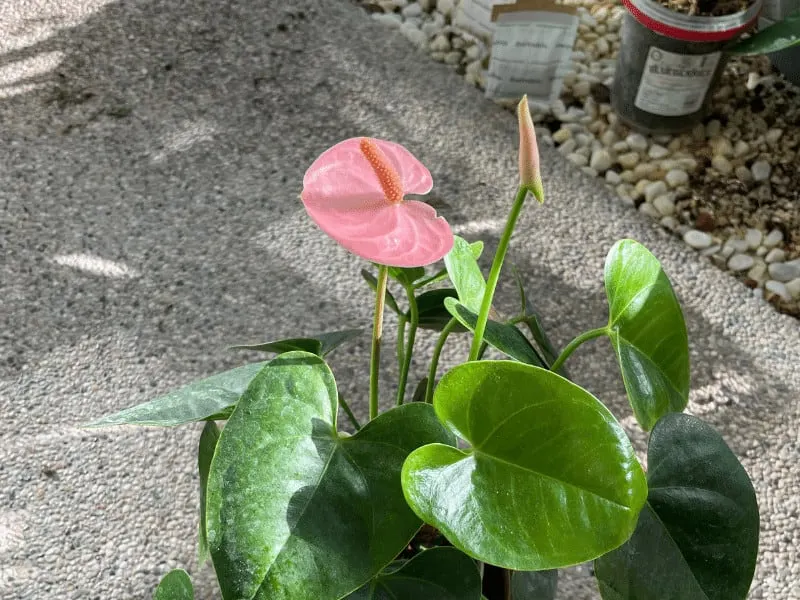
Anthurium scherzerianum
Anthurium scherzerianum is a plant that looks very similar to the Anthurium andreanum. A difference is that the scherzerianum has a curly spadix, which is the inner part of the flower. Scherzerianum also has more elongated leaves compared to the andreanum.
Anthurium Plant Benefits
Some of the most significant benefits of Anthuriums are that they purify the air. They remove pollutants. They are good for Feng Shui. They symbolize love and friendship.
Read all about the benefits of Anthuriums.
What are Aerial Roots?
Anthurium plants produce aerial roots or air roots. These are used to attach to objects and other plants. Air roots also take in nutrients as well as humidity above the soil.
What are the Anthurium Roots Above the soil.
Frequently Asked Questions
Is an Anthurium an annual or perennial?
Anthuriums are considered to be perennials, meaning that they can come back for multiple seasons after blooming. Remember, they often bloom for three months at a time. And these blooms can happen multiple times a year.
Conclusion About Anthurium Plant Care
Provide well-draining soil and bright indirect light to care for an Anthurium plant. Water once a week as a general rule of thumb, and keep the soil slightly moist but never soggy. Ideal temperatures are between 77-92°F (25-32°C). The humidity should be between 70-80% for the best growth. Use a liquid fertilizer once every 2-weeks in spring and summer and once a month in autumn and winter.

Daniel has been a plant enthusiast for over 20 years. He owns hundreds of houseplants and prepares for the chili growing seasons yearly with great anticipation. His favorite plants are plant species in the Araceae family, such as Monstera, Philodendron, and Anthurium. He also loves gardening and is growing hot peppers, tomatoes, and many more vegetables.

